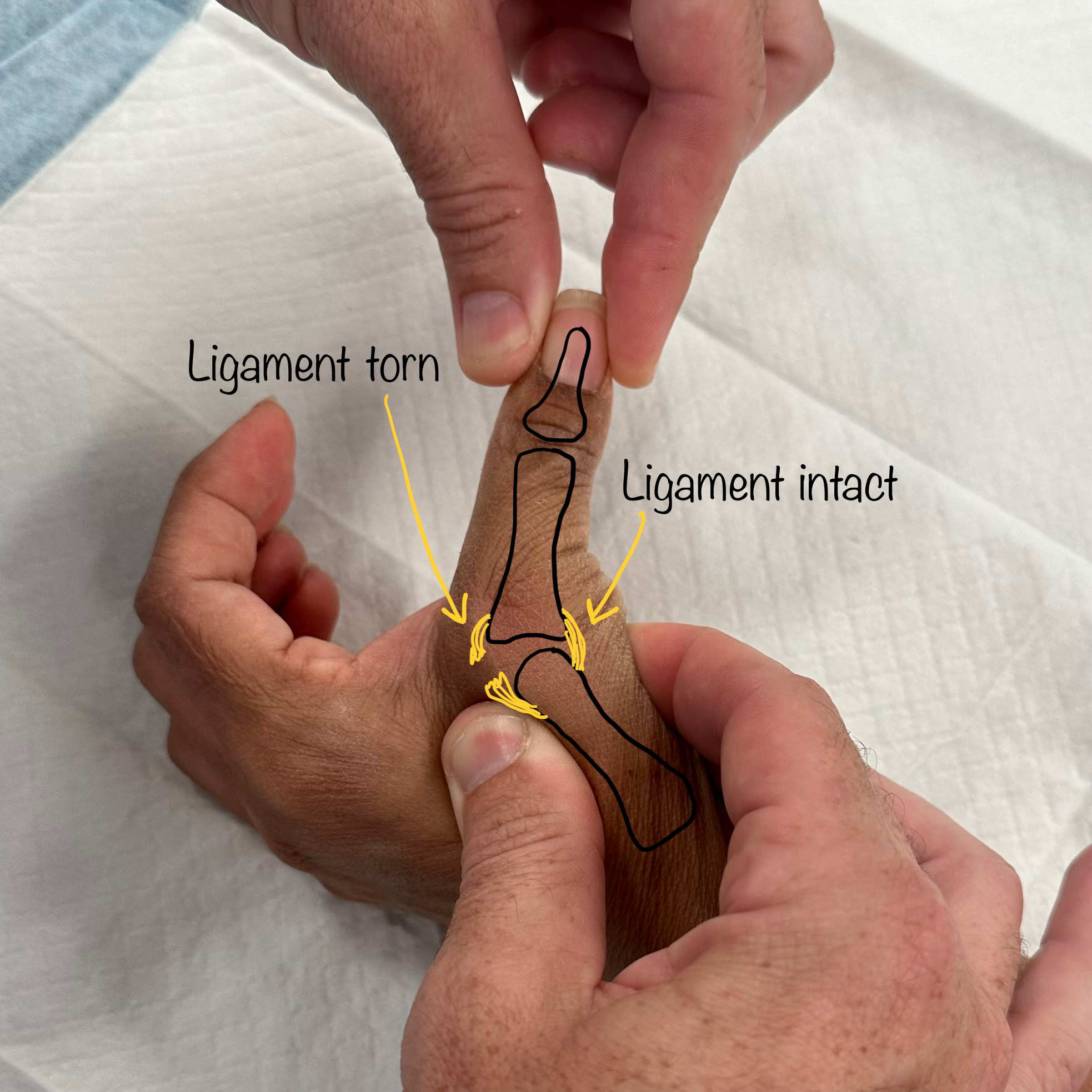Thumb Ligament Injuries (Skier's Thumb)
Thumb ligament injuries most commonly involve the ulnar collateral ligament (UCL) at the metacarpophalangeal (MCP) joint, the base of the thumb. Known as Skier’s Thumb, these injuries compromise pinch strength and joint stability, impacting daily activities like gripping and writing

Causes of pathology
Thumb UCL injuries can be caused by various factors
These injuries often result from forced thumb abduction or hyperextension, such as falling on an outstretched hand or catching a ski pole during a fall. They also occur in contact or ball sports where the thumb experiences sudden lateral force.
Chronic repetitive stress, known historically as “Gamekeeper’s Thumb”. can cause gradual UCL weakening and tearing over time.
- Acute trauma: A forceful impact or sudden hyperextension of the thumb, such as during a fall or while gripping an object tightly, can cause UCL damage or rupture.
- Sports involvement: Activities that involve gripping or holding objects, such as skiing, snowboarding, or contact sports, increase the risk of thumb UCL injuries.
- Repetitive stress: Repeated stress or overuse of the thumb joint, such as in certain occupations or activities, can contribute to UCL damage over time.
Symptoms
The symptoms of thumb UCL injuries may include:
Patients typically report sharp pain and tenderness at the inner base of the thumb, often accompanied by swelling and bruising. Instability during pinch or grasp, reduced grip strength, and limited thumb motion are common signs, especially in Grade 2 or 3 tears.
In complete tears, the Stener lesion may occur; where the torn ligament is displaced under tissue preventing natural healing.
- Pain: Sharp or localised pain at the base of the thumb, particularly during thumb movement or when gripping objects.
- Swelling and bruising: Swelling and bruising around the base of the thumb due to inflammation and bleeding into the tissues.
- Instability: The thumb may feel unstable or loose, with a diminished ability to grip or hold objects securely.
- Limited range of motion: Difficulty fully flexing or extending the thumb, which can affect daily activities.
Types of injury
Thumb UCL injuries can vary in severity, and they can be classified into different types:
Sprain: Partial tearing or stretching of the UCL without complete rupture.
Complete tear: Total rupture of the UCL, resulting in joint instability and loss of function.
Complete tear with Stener lesion: This variant occurs when the ligament ruptures and then gets caught, flipped out of position, and rests on an adjacent tendon. This tendon blocks the ligament from reattaching back onto the bone and has a high rate of causing long-standing issues without surgery.

Treatment options
Non-operative treatment
Non-operative treatment options may be considered for mild to moderate thumb UCL injuries, especially if the tear is not severe or if the patient's lifestyle and demands do not require surgical intervention.
Non-operative treatment typically include:
Immobilisation: Wearing a thumb splint or cast to immobilise the thumb joint and promote healing.
Ice and medication: Applying ice packs and taking over-the-counter pain relievers to reduce swelling and manage pain.
Activity modification: Avoiding activities that stress the injured thumb to prevent further damage.
Physical therapy: Once the acute phase has passed, a physical therapy program may be recommended to strengthen the surrounding muscles and restore thumb function.

Operative treatment
Surgical intervention is often recommended for severe thumb UCL injuries, complete tears, or cases where non-operative treatment has not provided satisfactory results. The surgical options may include:
UCL repair: The torn UCL is repaired using sutures or anchors to reattach the ligament to its proper anatomical position.
UCL reconstruction: In cases where the UCL is severely damaged or insufficient, a graft may be used to reconstruct the ligament.
Recovery & Rehabilitation
Recovery duration varies: mild sprains often resolve in a few weeks; moderate tears may take 4–12 weeks; and severe injuries or surgery may require several months before full mesh functionality returns. Close monitoring, progressive strengthening, and patient compliance support the best outcomes.
Dr Oscar Brumby‑Rendell provides expert diagnosis and trauma care for thumb ligament injuries at the Adelaide Shoulder & Upper Limb Clinic.
With advanced imaging and clinical exam, he customizes treatment plans to each patient’s injury severity and lifestyle needs. For stable injuries, he initiates conservative care combining splinting and physiotherapy. For severe tears or Stener lesions, he performs high-precision arthroscopic or mini-open ligament repair. Each patient receives a personalized rehabilitation plan to restore stability, strength, and full thumb function efficiently and safely.
Frequently Asked Questions
A Stener lesion occurs when, after a complete rupture of the ulnar collateral ligament (UCL) of the thumb, the torn ligament gets trapped above the adductor aponeurosis, preventing it from lying back in its normal position to heal properly.
Because it blocks natural healing, a Stener lesion typically necessitates surgical repair rather than conservative treatment.
Ready to Recover Grip Strength?
If you're experiencing thumb pain, instability, or difficulty pinching, don’t wait. Early diagnosis and treatment are essential to prevent long-term weakness or arthritis from UCL injuries.

Ready to learn more?
Discover more hand-related injuries with Dr Oscar Brumby-Rendell by watching this video.
Once you have a referral…
Book your consultation here.
